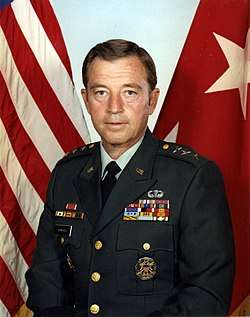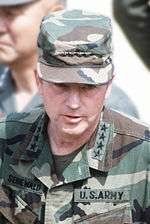Robert W. Sennewald
Robert William Sennewald (born November 21, 1929) is a retired United States Army general.
Robert W. Sennewald | |
|---|---|
 Pictured as a lieutenant general in September 1981 | |
| Born | November 21, 1929 St. Louis, Missouri, U.S. |
| Allegiance | |
| Service/ | |
| Years of service | 1951–1986 |
| Rank | |
| Commands held | Eighth U.S. Army |
| Spouse(s) | Nancy Vance Sennewald (d. 2003; death) |
| Other work | Consultant |
Early life and education
Sennewald was born on November 21, 1929 in St. Louis, Missouri as the only child of Ferdinand and Mabel Sennewald.[1][2][3] He was commissioned in 1951 through the Reserve Officer Training Corps upon graduation from Iowa State University with a degree in physical education. While at Iowa State he was affiliated with Phi Kappa Psi fraternity. Sennewald is an Iowa State University Distinguished Alumni Award winner.
Career

His assignments included command of: 6th Battalion, 15th Artillery, 1st Infantry Division in Vietnam; Division Artillery, 4th Infantry Division (Mechanized) at Fort Carson, Colorado; and the U.S. Army Training Center at Fort Dix, New Jersey.
He served as Assistant Chief of Operations (C3/J3) for the ROK/US Forces in Korea, and Deputy Commander, United States Pacific Command.
Sennewald served as Commander in Chief, U.N. Command/Commander in Chief, ROK/U.S. Combined Forces Command/Commander, U.S. Forces Korea/Commanding General, Eighth U.S. Army (CINCUNC/CINCCFC/COMUSFK/CG EUSA) from 1982 to 1984; and as Commanding General, U.S. Army Forces Command (CG FORSCOM) from 1984 to 1986. Sennewald was promoted to four star rank on May 24, 1982.
He retired from the U.S. Army in 1986. In 1994, he established Sennewald Associates which does consulting work on national security issues,[4] and has served as Chairman of the Army and Air Force Mutual Aid Association, on the board of the Armed Services YMCA,[5] and on the Advisory Council of the United States Field Artillery Association.[6]
References
- "Sennewald Associates".
- "ASYMCA Board of Directors". Archived from the original on 2006-11-04.
- "More Artillery Who's Who".